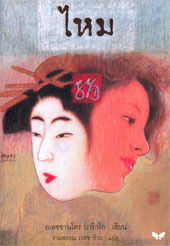 Nayomi Munaweera’s What Lies Between Us records a young girl’s disrupted childhood spent in Sri Lanka of the late 1970s and early 1980s, her being removed to an alien United States, where she strives to attain location, and her subsequent marriage to an up and coming artiste, Daniel, and its subsequent falling apart. Compared to Munaweera’s Island of a Thousand Mirrors, this second novel offers the reader a compelling and engaging read, which often shocks and takes the audience along a maze of twists and turns. But, as a work, altogether, What Lies Between Us leaves us with many abnormalities and incongruities, that caution our overall judgment of it.In a word, the novel disintegrates as a project that opens with promise, but which loses its potential in the process of things.
Nayomi Munaweera’s What Lies Between Us records a young girl’s disrupted childhood spent in Sri Lanka of the late 1970s and early 1980s, her being removed to an alien United States, where she strives to attain location, and her subsequent marriage to an up and coming artiste, Daniel, and its subsequent falling apart. Compared to Munaweera’s Island of a Thousand Mirrors, this second novel offers the reader a compelling and engaging read, which often shocks and takes the audience along a maze of twists and turns. But, as a work, altogether, What Lies Between Us leaves us with many abnormalities and incongruities, that caution our overall judgment of it.In a word, the novel disintegrates as a project that opens with promise, but which loses its potential in the process of things.
Foremost among Munaweera’s “shortcomings”, is the lack of smooth synchronization among the three main time threads she deals with, in recording the protagonist Ganga’s experiences from childhood to her life as an adult. The three main threads of childhood in Kandy, in Central Sri Lanka, the crossover to migrant United States, and the life of the protagonist as a nurse and mother are very loose in their binding, to say the least. Very often, one gets the feeling that these three sections were written independently and later patched up together,. leaving behind a sense of dissonance which discomforts the reader. Of the three segments, the best written, in my opinion, is the section dealing with childhood: this, in spite of Munaweera’s unbearably orientalist preoccupations in setting out the landscape and culture that surround young Ganga in the outskirts of Kandy. The often romanticized and exoticized layout of the family home, the idyllic atmosphere penetrated by Eden-like descriptions and definitions are often underlined by a sense of danger and threat, giving Ganga’s childhood an ambiguous, treachery-lurking, pastoral backdrop. Interestingly, the descriptions of the United States lack the same exotic punch, which Munaweera saves exclusively for her mapping of the non-urban, Lankan terrain.
The Kandyan setting, in spite of Munaweera’s best intentions, is a tad unrealistic for the mid 1980s. Ganga is educated in a leading girls’ school in Kandy, and is brought up according to the best interests of the walauvva tradition, but is seen to be let loose after school to wander the streets buying cheap ice palams and thoroughfare merchandise. Munaweera also refers to threewheelers in which children are being transported, which, for Ganga’s class in the mid 1980s, can be argued to be quite unrealistic. The home and the culture from which Ganga springs is marked as traditional Sinhala at an overwhelming level. Yet, we have a case where her father (later, reconfigured for us as a molester of his own child) baptizes his fellow playmate cum servant as “Samson”; and indeed, where the same Samson ponders on his isolation, claiming that he has no Delilah to couple him. The inclusion of the biblical motif is both abrupt and unrealistic, given the closed Sinhala and Buddhist ethos in which the childhood story is grounded.
 This very Samson is the “demon” that haunts Ganga’s life, even as she crosses continents. Her impressions of having being molested and violated by Samson leave an imprint on her which she struggles with even in her older years. Samson’s grabbing her, his hands on her person and her inability to resist his touch are graphically described through extensive paragraphs. Yet, in the concluding chapters, Ganga’s mother, through one single long distance phone call, and a decade and a half later, too, undoes all that by telling the daughter (over the phone, long distance) that her real violator was her own father, and not Samson, the servant. This, after graphic revelations of paragraphs and paragraphs of Samson hounding young Ganga. Could a girl, in her adolescence mistake one perpetrator for another: her own father, for Samson? When being “approached”, Ganga is into her early adolescence, between the ages 11 and 14. Besides, why does the mother take almost 15 years to reveal this disturbing truth to the daughter? And, how realistic or plausible is it for her to go into this detailed confession over a single phone call, when the daughter calls her to inform that Daniel, her husband, has left her? This becomes even more baffling as Ganga’s mother is often presented to us as a pragmatic “traditional-minded” woman, who operates within set boundaries. I suggest that Munaweera’s revelation of Ganga’s perpetrator to be her father, and not Samson, is a twist in the plot that undermines the quality of her narrative. It is a twist that is not supported by the build up of the narrative, nor by the logic and evidence the narrative offers us. It is a singular revelation that is meant to shock, but is ungrounded and unsupported by preceding events.
This very Samson is the “demon” that haunts Ganga’s life, even as she crosses continents. Her impressions of having being molested and violated by Samson leave an imprint on her which she struggles with even in her older years. Samson’s grabbing her, his hands on her person and her inability to resist his touch are graphically described through extensive paragraphs. Yet, in the concluding chapters, Ganga’s mother, through one single long distance phone call, and a decade and a half later, too, undoes all that by telling the daughter (over the phone, long distance) that her real violator was her own father, and not Samson, the servant. This, after graphic revelations of paragraphs and paragraphs of Samson hounding young Ganga. Could a girl, in her adolescence mistake one perpetrator for another: her own father, for Samson? When being “approached”, Ganga is into her early adolescence, between the ages 11 and 14. Besides, why does the mother take almost 15 years to reveal this disturbing truth to the daughter? And, how realistic or plausible is it for her to go into this detailed confession over a single phone call, when the daughter calls her to inform that Daniel, her husband, has left her? This becomes even more baffling as Ganga’s mother is often presented to us as a pragmatic “traditional-minded” woman, who operates within set boundaries. I suggest that Munaweera’s revelation of Ganga’s perpetrator to be her father, and not Samson, is a twist in the plot that undermines the quality of her narrative. It is a twist that is not supported by the build up of the narrative, nor by the logic and evidence the narrative offers us. It is a singular revelation that is meant to shock, but is ungrounded and unsupported by preceding events.
In America, the country to which Ganga migrates as an early teen, she gradually manages to find her own feet, metamorphosing into an agent who is both independent and able. Her constant childhood “demon” of Samson lurking around to grab her from behind doesn’t feature in her transitional phase, though it makes a dramatic comeback in the years after her childbirth. Where was Samson’s demon between the years 14 and 29-30, when Ganga seems to have settled down to a stride of uneasy transmission from one culture to another; one continent to a new, alien land? What makes the Samsonian demon return, abruptly, in the first year after her child birth? Ganga’s husband, Daniel, is initially presented to us as a responsible and loving individual. When Ganga is perturbed and withdrawn after their initial physical interaction, it is Daniel who sets the pace to the relationship, giving the would-be partner room and space with mature understanding. His behaviour in the aftermath of childbirth, is, therefore, all the more baffling and inconsistent, as he walks away from Ganga, asking her to “sort her issues out”, on her own, while deeming her too dangerous to live with or to have around their child. If inconsistencies infiltrate Munaweera’s script in the migrant setting, the most notable is the turnaround seen in Ganga’s mother’s. Her migraines and aloof spells, which dominate her Kandyan days, are never seen to bother her in the US, where she invests long hours at work and is seen to be perfectly functional and efficient. This transformation is both inconsistent as much as it is intriguing.
Munaweera, in the novel, has reinforced a series of hacked stereotypes that are often located within “traditional Lankan” culture, when it is accessed from an outsider’s periscope. This alone is one of Munaweera’s achievements in representing a Sri Lanka through her trans-continental stance. The stereotypes and traditional readings of customs, rituals and cultural figures, as Munaweera presents them, are valid and present, but are showcased as trivializations and without a depth that may assist in the representation of the complexity of cultural practice. Stained clothes sought by mother-in-laws after wedding nights, puberty rituals, taboos and prohibitions, as well as the in group gossip among women at a friend’s party are presented merely to chastise those acts; and are not seen within a context that is culturally meaningful. Neither education, exposure nor westernization seem to affect the “traditional-minded” in Munaweera’s text, such as Ganga’s mother, who resort to the “heirloom of culture” as a fossil to carry and maintain. The sections set in the United States are also hampered by a sense of hurried urgency and awkwardness in movement, which set them apart from the carefully meditated prose of the Kandyan chapters.
Munaweera has several memorable moments, too, which have to be acknowledged as part of high points in her delivery. Ridden of the gross exoticization and embellishment, the Kandyan chapters come across as engaging reading: specially, as records of a collation in retrospection. The re-visit to childhood and the detail of recollection are triumphs that satisfy the reader, keeping her engaged and inquisitive. In the same way, Munaweera has also evolved as a writer from her Island of a Thousand Mirrors, daring to be defying and uncompromising in her delivery. The earlier novel, in spite of international awards and such, was a disaster and a let down: a laboriously strung story, all undone within the last quarter of the narrative. Similarly, What Lies Between Us ends weakly, and imploding the groundwork of the early sections of the novel. Ganga’s “metamorphosis” to being a shade of her mother in her post-natal years is sudden and contrived. The sudden withdrawal of the otherwise supportive Daniel is equally unexplained. Moreover, the decision to kill Bodhi, the daughter, a decision taken in a hazy state of mind, is as much a shock tactic as a pair of boots bought at a garage sale. Outside the courthouse where Ganga is put on trial, there is a placard being held by a protester equating Ganga to a modern day Medea. The crucial difference here is that Medea’s killing of her children are logically explained and grounded in Euripedes’ text, while the impetus behind Ganga’s actions do not come out satisfactorily.
What Lies Between Us is a novel that opens promisingly, but freckles up and snaps off at the half way point. The childhood story of Ganga has in it the grip to hold the audience, but Munaweera fails to convert this impetus to a meaningful end.
Advertisements Share this:




